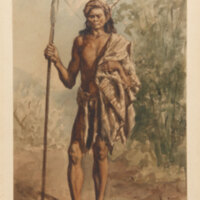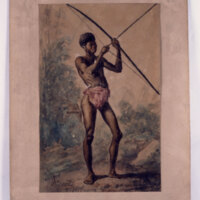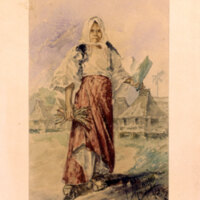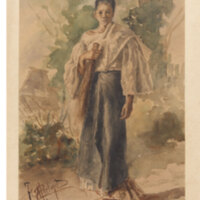Moro en traje de guerra
Text
Plate in which a male character is represented in a warrior's outfit.
Written above the drawing and below at the bottom of the sheet in Spanish Philippine Moor in war attire.
Signatures at the Lower Right Corner:
Martínez y Lorenzo, Félix (1886) F. Martinez
Share this
Media
Images
Map National Anthropology Museum Madrid
Metadata
Creator
Félix Martínez y Lorenzo (ca. 1859 - 1916)
Date
1886
Identifier
CE2387
Origin
Manila (National Capital Region, Philippines)
Materials
Paper, Watercolor (Pigment, Gum Arabic)
Physical Dimensions
Height = 345 mm; Width = 222 mm
Provenance
In the Catálogo de la exposición general de las Islas Filipinas celebrada en Madrid ... el 30 de junio de 1887 ( access online here),
Don Felix Martinez y Lorenzo had the following pieces in the Exposition:
Acuarelas de tipos del pais
La naturaleza cuadro de oleo
Recuerdos de tipos del pais
Retratos al lápiz de Mrs Mackennan y de doña Ella Pauli de Vidal reproduction ampliada de fotografias
El deber cumplido, cuadro de oleo
In the Fine Arts section of the Exposition, Martinez exhibited these works along with works by Juan Luna and Felix Resurrection Hidalgo. (Catalogo, 1887:596). When the Exposition ended, many of the paintings and sculptures became part of the foundational collection of the Museo Biblioteca de Ultramar which was established a year later. When this Museum closed in 1908, the works of art were moved to the Museo de Arte Moderno. Most of the oil paintings remained at the Prado, while others, including the Martinez watercolours were sent on permanent loan to the National Museum of Anthropology in Madrid. There is no record of how many pieces were in the Tipos del Pais that Martinez submitted to the 1887 Exposition, but there are 19 pieces of Martinez's from the Acuarelas de tipos del pais at the Museo.
About the artist:
According to an article by Blas Sierra de la Calle, Félix Martínez y Lorenzo was born 1859-c.1916 in Santa Cruz Manila, and was a member of a family of artists. He attended the University of Sto. Thomas for high school, finishing in 1877 where he obtained the qualification of outstanding in art under the Spanish Dominican professor Fr. Joaquín Sabater.
His first known work appeared in La Ilustración del Oriente in 1878, when the artist was only 19 years old.
He began to establish himself when he took part in a project promoted by the Agustinians of Manila - the publication of Flora de Filipinas by Manuel Blanco. Martinez made 47 of the designs, which later served as the basis for the lithographs, both in white and black as well as in colour.
He was the illustrator for La Ilustración Filipina (1894-96) - many of his works depicting Philippine daily life.
At the end of the 19th century, the artist painted for several churches including the Church of San Ignacio of Manila in 1889. He was appointed a professor at the La Escuela Práctica Profesional de Artes y Oficios de Manila in 1891 - occupying the post of professor of modelling and casting until the end of Spanish colonisation in 1898.
He continued to produce work and exhibited and won medals in various Expositions, including the Universal Exposition at St Louis in 1904. The date of his death is unknown, but if the Execution of Dr Jose Rizal (1915) is his last work, then Martinez most likely died in 1916.
Don Felix Martinez y Lorenzo had the following pieces in the Exposition:
Acuarelas de tipos del pais
La naturaleza cuadro de oleo
Recuerdos de tipos del pais
Retratos al lápiz de Mrs Mackennan y de doña Ella Pauli de Vidal reproduction ampliada de fotografias
El deber cumplido, cuadro de oleo
In the Fine Arts section of the Exposition, Martinez exhibited these works along with works by Juan Luna and Felix Resurrection Hidalgo. (Catalogo, 1887:596). When the Exposition ended, many of the paintings and sculptures became part of the foundational collection of the Museo Biblioteca de Ultramar which was established a year later. When this Museum closed in 1908, the works of art were moved to the Museo de Arte Moderno. Most of the oil paintings remained at the Prado, while others, including the Martinez watercolours were sent on permanent loan to the National Museum of Anthropology in Madrid. There is no record of how many pieces were in the Tipos del Pais that Martinez submitted to the 1887 Exposition, but there are 19 pieces of Martinez's from the Acuarelas de tipos del pais at the Museo.
About the artist:
According to an article by Blas Sierra de la Calle, Félix Martínez y Lorenzo was born 1859-c.1916 in Santa Cruz Manila, and was a member of a family of artists. He attended the University of Sto. Thomas for high school, finishing in 1877 where he obtained the qualification of outstanding in art under the Spanish Dominican professor Fr. Joaquín Sabater.
His first known work appeared in La Ilustración del Oriente in 1878, when the artist was only 19 years old.
He began to establish himself when he took part in a project promoted by the Agustinians of Manila - the publication of Flora de Filipinas by Manuel Blanco. Martinez made 47 of the designs, which later served as the basis for the lithographs, both in white and black as well as in colour.
He was the illustrator for La Ilustración Filipina (1894-96) - many of his works depicting Philippine daily life.
At the end of the 19th century, the artist painted for several churches including the Church of San Ignacio of Manila in 1889. He was appointed a professor at the La Escuela Práctica Profesional de Artes y Oficios de Manila in 1891 - occupying the post of professor of modelling and casting until the end of Spanish colonisation in 1898.
He continued to produce work and exhibited and won medals in various Expositions, including the Universal Exposition at St Louis in 1904. The date of his death is unknown, but if the Execution of Dr Jose Rizal (1915) is his last work, then Martinez most likely died in 1916.
Acquisition Date
1887
Short description
In the second half of the 19th century, Filipino painters and sculptors began to deal with non-religious themes and reproduce an indigenous style with realistic representations of the landscape, people and their daily activities, local scenes and customs, as well as tipos del pais - different types of people dressed in their daily and festive clothes. All this is closely related to European and Spanish customs. From that moment the artists are no longer anonymous, they begin to be recognized individually and to travel to Spain and other European countries to continue their training.
Display status
In storage
References
Indigenous art at the Philippine Exposition of 1887: Arguments for an ideological and racial battle in a colonial context
Luis Ángel Sánchez Gómez Journal of the History of Collections, Volume 14, Issue 2, November 2002, Pages 283–294, https://doi.org/10.1093/jhc/14.2.283
STA. MARÍA, F., & PILAR, S. A. (1998). Discovering Philippine art in Spain. Manila, Department of Foreign Affairs.
BLAS SIERRA DE LA CALLE. Félix Martínez y Lorenzo en la Ilustración Filipina Archivo Agustino 99 (2015) 419-546. Access here.
Luis Ángel Sánchez Gómez Journal of the History of Collections, Volume 14, Issue 2, November 2002, Pages 283–294, https://doi.org/10.1093/jhc/14.2.283
STA. MARÍA, F., & PILAR, S. A. (1998). Discovering Philippine art in Spain. Manila, Department of Foreign Affairs.
BLAS SIERRA DE LA CALLE. Félix Martínez y Lorenzo en la Ilustración Filipina Archivo Agustino 99 (2015) 419-546. Access here.
Official Website
Collection
Source
Record accessed in May 2021
Translated from Spanish by Google Translate
Translated from Spanish by Google Translate
Cite this Page
Félix Martínez y Lorenzo (ca. 1859 - 1916), “Moro en traje de guerra,” Mapping Philippine Material Culture, accessed April 24, 2024, https://philippinestudies.uk/mapping/items/show/6102.
Tags
Geolocation
Sensitive Content
Mapping Philippine Material Culture collates digital material from institutions, and some of this material is inherently colonial and contains words, terms and phrases that are inaccurate, derogatory and harmful towards Filipino and Filipino diasporic communities. Catalogue transcriptions, book titles, exhibition titles and museum titles may contain harmful terms. We recognise the potential for the material to cause physical and mental distress as well as evoke strong emotions. Owing to the scale of the collection’s data, a process to implement sensitive-content warnings in the displayed data is still incomplete. The material within the catalogue does not represent Mapping Philippine Material Culture’s views. Mapping Philippine Material Culture maintains a strong anti-colonial, anti-racist position and affirms its support for centring the humanity of historically marginalised and disenfranchised communities.
Facebook Twitter



